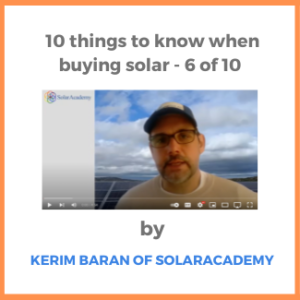In this sixth video in a ten-part training series of key concepts for people looking to buy a solar system, Kerim Baran of SolarAcademy talks about popular panel and battery companies and typical costs for the average solar array in the US. The entire series can be viewed here.
Below is the transcript of the video:
Kerim Baran of SolarAcademy: Next topic is equipment selection and and cost. As we discussed in the very beginning of the series a typical solar system consists of panels, inverters, racking and balance of system wires, connectors, disconnects and so forth.
The way the industry is shaped currently at year 2022 is that most of these systems are owned by separate companies although there is a rapid consolidation happening as the solar industry is growing and maturing. You see panel manufacturers acquiring battery companies or battery inverter companies doing strategic deals with panel manufacturers and battery companies. I can foresee in the future that maybe one single brand of company will have all solutions under them but that’s not yet the case.
So I just wanted to talk a little bit about what panels are popular and quality and what inverters and also what is the price for these. So on the panel side, you know, some some well-known and quality panels that have been in the market for a decade plus, and in certain cases close to two decades, are brands like REC, Hanwha Q CELLS, Canadian Solar, Jinko, Trina and Solaria, and SunPower, of course. And those are some of the better known panels. There are probably a couple dozen other brands that are all high quality.
Panels are not necessarily the most high-tech component in a solar system. Inverters are actually a lot more complicated and more higher tech. Some very well-known and established inverter brands are Enphase, SolarEdge, SMA, Sungrow. These are some of the better known inverter brands that have been in the market for a decade, decade plus in most cases. Then batteries – there’s of course Tesla, but there are a dozen other battery brands that are equally competitive and high quality like LG CHEM, Generac, Simplify and many others.
Now in terms of price, excluding the battery, for a typical photovoltaic solar system in the US sells around between $2.00 and 25 cents to $3.50 depending per watt. So a six kilowatt system, let’s assume it was priced at three dollars per watt, would cost you $18,000. Of course then there is a 26% federal Investment Tax Credit on that price, which means 26% of that eighteen thousand dollars, it’s about a quarter of that so let’s call it $4,500 gets to be deducted from your annual federal tax obligation. This is a great deal. It’s essentially a free cash coupon with the federal government that gives you f$4,500 of credit for your federal taxes. Almost like cash if you’re paying a ton of taxes.
If you’re not paying a ton of taxes because you’re retired and you don’t really have a ton of income or for whatever other reason then going solar with at least a third-party ownership might make sense. We’re going to talk about that later. But so this is basically the key information about equipment selection and cost. Most systems in the US, as we covered in our earlier sections, are 6 to 8 kilowatts in size and most pricing is between $2.00 and 25 cents to $3.00. On some really unique and high-end installations the cost might go over $3.50. If the size of the system is going over 8 kilowatt to 10 to 15 to 20 kilowatts for high-end homes, then the cost should also go down from $3.00 or $3.50 to $2.50 or closer to $2.25 as well. So those are just the basics on equipment selection and cost.
